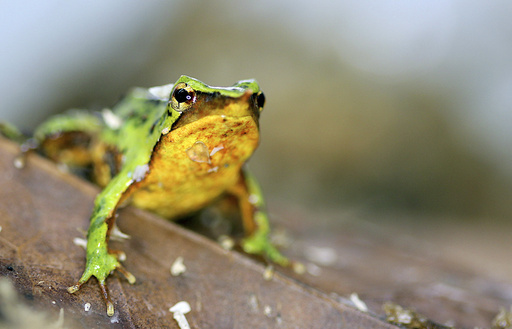
LONDON — In a remarkable effort to save an endangered species, a group of tiny Darwin’s froglets has traveled thousands of miles from the forests of southern Chile to their new home in London. These small amphibians journeyed inside the vocal sacs of their fathers for protection, highlighting the unique reproductive strategy of the species.
On Monday, London Zoo announced the birth of 33 Darwin’s frogs, a project that aims to rescue the species from the brink of extinction. The frogs were named after the renowned scientist Charles Darwin, who first discovered their existence. Recent reports indicated a staggering 90% decline in the known populations of Darwin’s frogs following the arrival of chytrid fungus, a lethal disease that infected their habitat in the Parque Tantauco forests of Chile in 2023. This fungus has had a devastating impact on numerous amphibian species worldwide.
The breeding method of Darwin’s frogs is quite fascinating; after the eggs are laid by females, it is the male frogs that take on the responsibility of protecting and nurturing the tadpoles within their vocal sacs until they are fully developed. In October, a dedicated team of conservationists ventured into the forests of Chile, hoping to find healthy Darwin’s frogs that were not affected by the chytrid fungus. Their efforts led to the collection of 52 frogs, which were subsequently transported in climate-controlled containers over a challenging 7,000-mile trip involving boats, cars, and planes.
Among those collected, 11 male frogs, each measuring less than 3 centimeters (1.2 inches), successfully carried 33 tadpoles that were later born at the zoo. Ben Tapley, the curator of amphibians at London Zoo, expressed the urgency of the initiative, stating, “We knew we were embarking on something special — the clock was ticking, and we needed to act quickly if we were going to save these frogs.” He also remarked that the successful rearing of the froglets serves as a “powerful symbol of hope for the species.”
Andres Valenzuela-Sanchez, a researcher with the conservation charity behind London Zoo, emphasized that this project not only plays a crucial role in the survival of the Darwin’s frogs but also enhances our understanding of combating chytrid fungus and protecting other amphibians around the world. “These frogs are not only vital for the future of their species but also help us better understand how we can combat chytrid fungus and safeguard other amphibians globally,” he highlighted, reinforcing the importance of this conservation effort.

